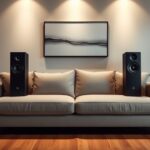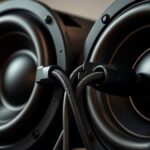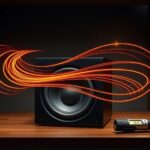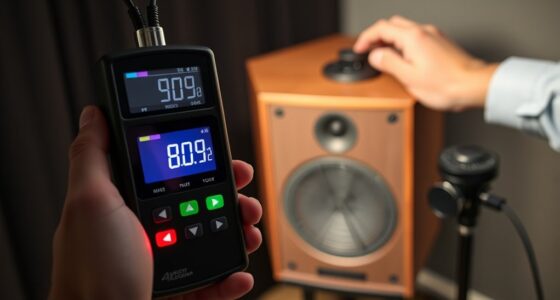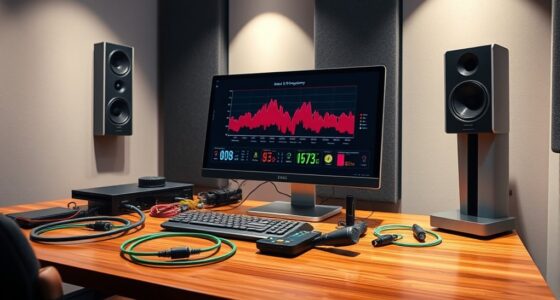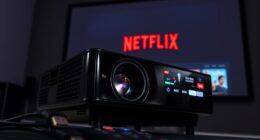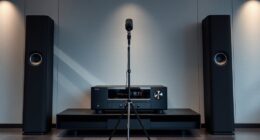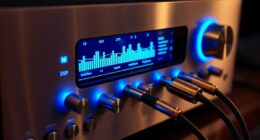To guarantee your speakers are in-phase, focus on correct wiring, proper placement, and polarity. Make sure positive and negative connections are consistent on both speakers and amplifiers. Position your speakers facing each other at equal distances to keep signals synchronized. Use test tones or polarity checkers to verify everything is aligned. Small adjustments can make a big difference in sound clarity and imaging, and if you want to learn more, there’s much more to explore about perfecting your audio setup.
Key Takeaways
- Proper speaker placement and facing directly help ensure signals arrive in phase at the listener’s position.
- Reversing speaker wiring or using a polarity tester can identify and correct phase issues.
- In-phase signals produce full, clear sound; out-of-phase causes hollow or canceled audio.
- Consistent positive and negative wiring maintains proper polarity and prevents phase cancellation.
- Fine-tuning positioning and conducting test tones optimize speaker in-phase alignment for better sound quality.
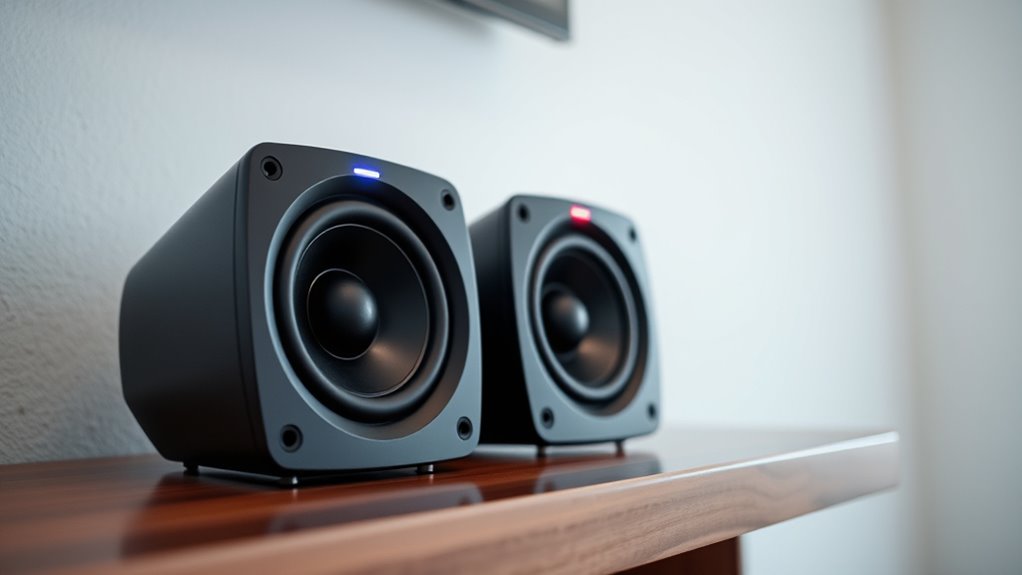
Understanding phase and polarity is vital when working with signals and waveforms, as these concepts determine how signals interact and combine. When setting up speakers, your goal is to guarantee that all audio signals arrive in sync, creating a cohesive and clear sound. Proper speaker placement plays an essential role here. If your speakers are positioned incorrectly, the audio signals reaching each ear can be out of phase, causing phase cancellation or reinforcement that muddles the sound. To prevent this, you need to pay close attention to how you position your speakers relative to each other and your listening position. Generally, aligning speakers to face the listener directly and maintaining equal distances helps keep the audio signals in phase. If one speaker is placed farther back or at an angle, the signals can arrive at different times, leading to phase issues. Additionally, understanding the impact of *interference* can help you minimize unwanted sound distortions caused by phase problems.
When working with audio signals, understanding polarity is equally important. Polarity refers to the positive and negative connections in your audio setup. If one speaker’s wiring is reversed—meaning the positive wire is connected to the negative terminal—you’ll introduce a phase shift in that speaker’s audio signal. This phase shift causes the sound waves to be out of sync with other speakers, resulting in a thin or hollow sound, and can even cancel out bass frequencies. To avoid this problem, always double-check your wiring and guarantee that positive and negative connections are consistent across all speakers. Some audio equipment has a polarity switch; using it correctly can help you quickly identify and fix polarity issues. Proper wiring and setup are fundamental to achieving optimal sound quality, as emphasized in interior design basics.
Testing your setup with simple tools, like a polarity checker or a test tone, can help you confirm that all speakers are in phase. When the signals are in phase, you’ll notice a full, rich sound with clear imaging. If the sound seems hollow or less impactful, it’s likely that your speakers are out of polarity or out of phase. By paying close attention to speaker placement and wiring, you control how your audio signals interact. When signals are properly aligned in phase and polarity, your system delivers top-notch sound quality, with accurate imaging and full frequency response. Remember, even small adjustments in positioning or wiring can make a significant difference in how your audio signals combine, so take the time to fine-tune your setup for the best listening experience.
Frequently Asked Questions
How Does Phase Affect Stereo Imaging?
Phase directly impacts stereo imaging by influencing how sound waves combine, affecting stereo depth and sound localization. When speakers are in-phase, sound waves align, creating a clear, centered image. If they’re out-of-phase, waves cancel each other, causing a hollow or unfocused stereo field. Ensuring proper phase keeps the stereo image stable, enhances depth perception, and accurately locates instruments and vocals within the mix, making your listening experience more immersive.
Can Incorrect Polarity Damage Speakers?
Incorrect polarity can damage speakers, especially if you reverse polarity during wiring or accidentally create a polarity reversal. When wiring speakers, verify all connections are correct to avoid phase issues that could cause driver stress or damage over time. While a single polarity reversal typically won’t cause immediate harm, continuous incorrect wiring can lead to distorted sound and long-term damage, so double-check your wiring to keep your speakers safe.
What Tools Are Best for Testing Phase?
Imagine you’re wielding a vintage oscilloscope, the ultimate tool for testing phase. You’ll want a phase tester or a multimeter with a phase check function to accurately assess phase response. These tools help you detect phase cancellation and guarantee speakers are in-phase, preventing sound issues. By checking frequency response and phase alignment, you ensure clean, balanced audio without unwanted cancellation, giving your system that perfect, professional sound.
How Does Phase Shift Impact Bass Response?
Phase shift can cause phase cancellation, which weakens bass response and reduces overall sound quality. When speakers aren’t in phase, bass reinforcement doesn’t occur as it should, leading to muddy or hollow sound. You’ll notice less punch and depth in your bass. To avoid this, make certain speakers are properly in-phase, so the sound waves reinforce each other instead of canceling out, resulting in fuller, more accurate bass.
Is Phase Alignment Necessary for Home Theater Systems?
In the days of dial-up internet, speaker calibration is still vital for your home theater system. You need to guarantee acoustic coherence by aligning the phase of all speakers. Proper phase alignment isn’t optional; it prevents sound from becoming muddy or echoing. When your speakers are in-phase, you get clear, balanced audio, making your movie nights immersive and enjoyable. Skipping this step can compromise your entire listening experience.
Conclusion
By mastering phase and polarity, you prevent your speakers from dancing out of sync, like a choir in perfect harmony. When you verify they’re in-phase, your sound becomes a seamless wave, delivering clarity and punch. Think of it as tuning an orchestra—you’re the conductor guiding every instrument to play together beautifully. Keep these principles in mind, and you’ll transform your listening experience into a symphony of pure, balanced sound.


